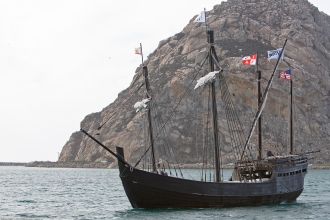  Christopher Columbus was born in 1451 in Italy. He was a master navigator and admiral whose four transatlantic voyages between 1492 and 1504) opened the way for European exploration, exploitation, and colonization of the Americas. Columbus made his transatlantic voyages under the sponsorship of Ferdinand II and Isabella I, the Catholic monarchs of Aragon, Castile, and Spain.
Christopher Columbus was born in 1451 in Italy. He was a master navigator and admiral whose four transatlantic voyages between 1492 and 1504) opened the way for European exploration, exploitation, and colonization of the Americas. Columbus made his transatlantic voyages under the sponsorship of Ferdinand II and Isabella I, the Catholic monarchs of Aragon, Castile, and Spain. He has long been called the 'discoverer' of the New World, although Vikings such as Leif Eriksson had visited North America five centuries earlier, and of course the indigenous peoples populating the West Indies and the Americas had been there for thousands of years. According to the older understanding, the 'discovery' of the Americas was a great triumph, one in which Columbus played the part of hero in accomplishing the four voyages, in being the means of bringing great material profit to Spain and to other European countries, and in opening up the Americas to European settlement. A more recent perspective, however, has shown the destructive side of the European conquest, pointing out, for example, the disastrous impact of the slave trade and the ravages of imported disease on the indigenous peoples of the Caribbean region and the American continents.  The first voyage, comprising three ships, the Niña, Pinta, and Santa María, left on August 3, 1492. (Replica of the Nina shown at left). The impetus for the undertaking was fueled by many things: Christian missionary and anti-Islamic fervour, the fear of Portugal, the lust for gold, the desire for adventure, the hope of conquests, and Europe’s genuine need for a reliable supply of herbs and spices for cooking, preserving, and medicine. These all combined to produce an explosion of energy that launched the first voyage.
The first voyage, comprising three ships, the Niña, Pinta, and Santa María, left on August 3, 1492. (Replica of the Nina shown at left). The impetus for the undertaking was fueled by many things: Christian missionary and anti-Islamic fervour, the fear of Portugal, the lust for gold, the desire for adventure, the hope of conquests, and Europe’s genuine need for a reliable supply of herbs and spices for cooking, preserving, and medicine. These all combined to produce an explosion of energy that launched the first voyage. Islamic powers had effectively closed the land routes to the East and made the sea route south from the Red Sea extremely hard to access. A great number of backers were involved in this adventure, which was an attempt to find a route to the rich land of Cathay (China), to India, and to the gold and spice islands of the East by sailing westward over what was presumed to be open sea. Of course, the Americas stood in the way. First landfall is believed to have been at San Salvador in the Bahamas. Beyond planting the royal banner, however, Columbus spent little time there, eager to continue on to Japan. He thought that he had found it in Cuba, where he landed on October 28, but he soon convinced himself, without any evidence, that Cuba was actually the China mainland itself. On December 5, he headed southeast to search for the Chinese city of Zaiton, missing a chance of setting foot on Florida soil. He ended up on an island called Ayti (Haiti) by its inhabitants; Columbus renamed it Hispaniola. He seems to have thought that Hispaniola might be one of the legendarily rich isles from which King Solomon’s fleet brought back gold, gems, and spices to Jerusalem. Despite his utter confusion about his location, he managed to find enough gold to save him from ridicule on his return to Spain. While returning to Spain, the Niña and Pinta encountered the roughest storm of their journey, and on the night of 13 February, lost contact with each other. Landing in the Azores, Columbus on the Nina encountered hostile inhabitants, with some of his crew being kidnapped, although they were eventually released. There were many problems on this first voyage, causing tensions that would persist throughout the next three voyages. Columbus' religious and even mystical aspirations were incompatible with the realities of trading, competition, and colonization. He also exhiited autocratic leadership that made him many enemies. In addition, Columbus was determined to take back both material and human cargo to his patrons and for himself, and this could be accomplished only if his sailors carried out looting, kidnapping, and other violent acts, especially on Hispaniola. On his subsequent voyages he went farther south, to Central and South America. He never got close to what is now called the United States. Columbus always maintained that he had found Cathay in the face of mounting evidence that he had not. You can read about Columbus' second, third and fourth voyages here. Columbus died in 1506, still believing that he had found a new route to the East Indies. Today his historic legacy as a daring explorer who discovered the New World has been challenged. His voyages launched centuries of European exploration and colonisation of the American continents. but also triggered centuries of exploitation of indigenous peoples. |